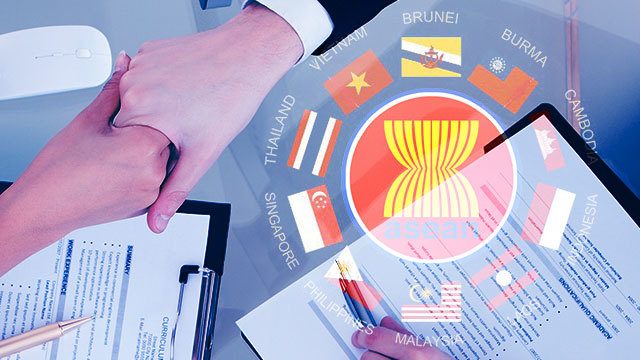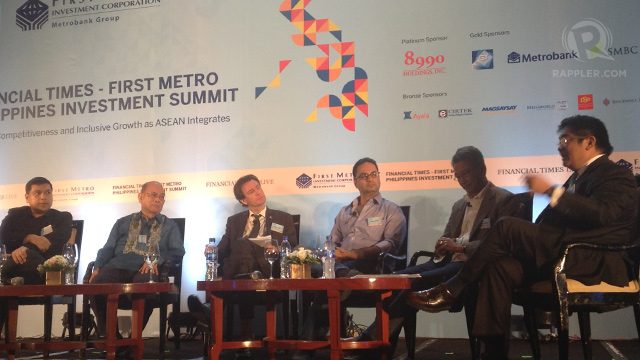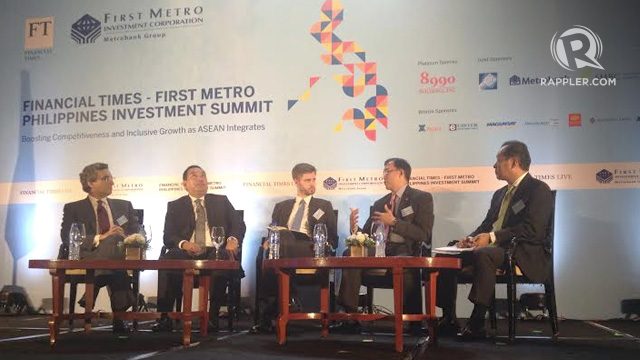SUMMARY
This is AI generated summarization, which may have errors. For context, always refer to the full article.

MANILA, Philippines – Will a borderless economic community disrupt the growth the Philippines has worked hard for over the last 3 years?
Speakers at the second annual Financial Times-First Metro Philippines Investment Summit in Makati city on Wednesday, May 20, agreed that the Philippines is in a position to maximize opportunities presented by the region’s integration into one economic bloc by December 31, 2015.
Businessmen and analysts, however, noted that there are challenges that need to be hurdled to realize the country’s full potential.
“The 6%-7% GDP (gross domestic product) growth we are experiencing over the last 3 years is sustainable indefinitely,” Bernardo Villegas, University of Asia and the Pacific’s (UA&P) professor and Center for Research and Communication head, told a panel interview at the Makati summit.
GDP is the measure of goods and services produced across the economy.
Villegas added: “Only an earthquake like in Nepal and several typhoons like Yolanda can disrupt the growth of the Philippine economy. This is because of the political reforms made by former President Cory Aquino up to the incumbent.”
The Philippines’ GDP last year registered a 6.1% or P12.63 trillion ($286.20 trillion) growth but fell below the government target of 6.5% to 7.5, and lower than the record-high 7.2% growth in 2013 or P11.55 trillion ($261.72 billion) at prevailing rates. Analysts said the government missed its target owing largely to government underspending.
The World Bank predicts that Philippine economic growth could surpass 6.5% this year should the government fully utilize its budget as planned, implements proposed infrastructure projects, and accelerates reforms.
“If we’re able to do something about the inability of the government to implement infrastructure projects faster, the GDP growth could even be between 8%-10%,” Villegas said. “Imagine what increased airports and railways can bring to the economy.”

Of the over 50 public-private partnership (PPP) projects in the government pipeline, only 9 were awarded and signed by the Aquino administration. At least 12 projects are currently in the procurement stage and 9 more are expected to be rolled out within the year.
Citing the Infrascope 2011 Study of the Economist Intelligence Unit commissioned by the Asian Development Bank, the PPP Center said in January the Philippines was ranked highest in terms of PPP readiness in the ASEAN region, given its “advanced legal and administrative structure.”
Long way to go
For his part, Finance Secretary Cesar Purisima said, “The better governance program President [Benigno] Aquino [III] brought to the country is understated.”
“When you look at businesses, they are now more confident. They started lowering risk and creating more productive expenditures. This allows the country to be more aggressive come the ASEAN integration,” he added.
Purisima explained how “good governance” helped the country to be more optimistic of its economic future, even with the integration.
“First, transparency. People are being allowed to evaluate if changes are really happening. Two, rule of law and the responsiveness of the government. And others are inclusiveness, accountability and participation,” he said.
Purisima cited some of the reforms of the Aquino administration such as “doubling the budget of Department of Education, tripling those of Department of Health and recognizing the importance of infrastructure” but acknowledged that the country still has a “long way” to go.
“What President Aquino did is to point it in the right direction. These small steps the President started are very important when it comes to signaling other ASEAN members that we mean business when it comes to good governance. There’s no magic wand wherein we can just rise among them instantly,” he said.

In anticipation of regional integration through the ASEAN Economic Community (AEC), the Philippine government is taking steps to strengthen local industries by improving governance and enhancing competition – especially for small enterprises and start-ups, Purisima said.
Mixed insights
Businessmen, however, gave mixed insights on the private sector’s role in enabling the Philippines to compete on the international playing field.
“I think the Philipines is a very attractive place for manufacturing. We are truly one of the highest in terms of numbers of factories in the ASEAN region. Perhaps the issues needed to be addressed are more of bureaucratic processes, like of contracts,” Hans Sicat, Philippine Stock Exchange president and CEO, answered in one of the panel discussions.
For Roberto Juanchito Dispo, president and director of First Metro Investment Corporation, he said he sees “more synergies happening when it comes to regional banks, like Taiwanese, Japanese and Korean. Most foreign banks are making their entries here.”
“This will raise banking standards,” Dispo said.
Sicat agreed with Dispo. “The financial markets are better. It also raises the bar for local companies, imposing higher appreciation of what needs to be done. This also opens opportunities of partnerships.”
For some businessmen, local companies should tap into emerging trends in consumer demand accross the region.
Jesus Atencio, 8990 Holdings president and CEO cited an example: “For us, we are actually disrupting notions that low-cost housing is no-cost housing. To disrupt the idea, we put up wakeboarding, basketball gyms and other leisure establishments in our subdivisions and medium-rise residential buildings.”
“For us, we invest in companies that disrupt some major companies,” said Dado Banatao, managing partner of Tallwood Venture Capital.
Banatao added: “Disruption is just a start of an innovation. It is the effect of the beginning of all things. Things that have not been done before. This is how local firms can compete with other ASEAN companies by yearend.”
Nico Jose Nolledo, Xurpas, Incorporated chairman and president, said: “We’re listed in PSE. Apparently, there’s no consumer technology company listed in Southeast Asia. That’s how we disrupted the ASEAN economy, by targeting a niche no one has ever seen.”
“When you have that lens, you can be a leader….Game development studios tend to target application stores. For us, we’re able to create a new market through targeting consumers. We worked with telecom companies, using prepaid loads as a form of currency,” he added.
Nolledo also posed a query. “Now, the question is, are local firms ready to be market disruptors or be disrupted?”
This year’s Financial Times-First Metro Philippines Investment Summit was centered on the theme, “Boosting competitiveness and inclusive growth as ASEAN integrates.” – Rappler.com
$1=P44.57
Add a comment
How does this make you feel?
There are no comments yet. Add your comment to start the conversation.